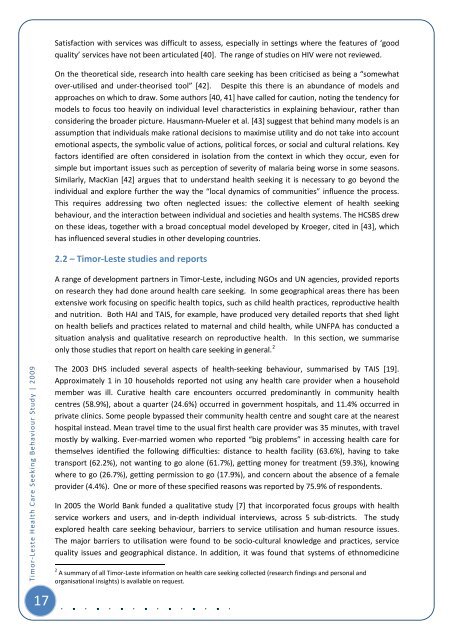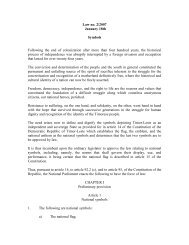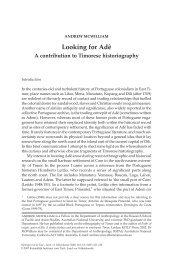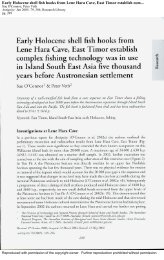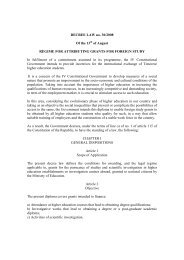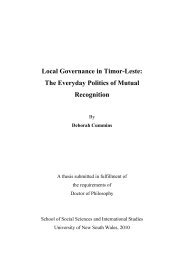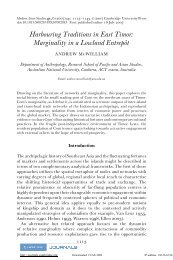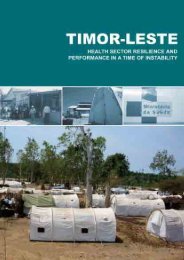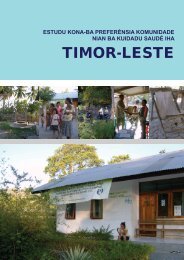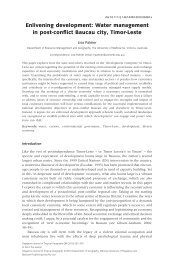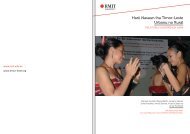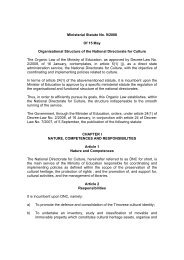Timor-Leste Health Care Seeking Behaviour Study - Secretaria de ...
Timor-Leste Health Care Seeking Behaviour Study - Secretaria de ...
Timor-Leste Health Care Seeking Behaviour Study - Secretaria de ...
- No tags were found...
You also want an ePaper? Increase the reach of your titles
YUMPU automatically turns print PDFs into web optimized ePapers that Google loves.
Satisfaction with services was difficult to assess, especially in settings where the features of ‘goodquality’ services have not been articulated [40]. The range of studies on HIV were not reviewed.On the theoretical si<strong>de</strong>, research into health care seeking has been criticised as being a “somewhatover-utilised and un<strong>de</strong>r-theorised tool” [42]. Despite this there is an abundance of mo<strong>de</strong>ls andapproaches on which to draw. Some authors [40, 41] have called for caution, noting the ten<strong>de</strong>ncy formo<strong>de</strong>ls to focus too heavily on individual level characteristics in explaining behaviour, rather thanconsi<strong>de</strong>ring the broa<strong>de</strong>r picture. Hausmann-Mueler et al. [43] suggest that behind many mo<strong>de</strong>ls is anassumption that individuals make rational <strong>de</strong>cisions to maximise utility and do not take into accountemotional aspects, the symbolic value of actions, political forces, or social and cultural relations. Keyfactors i<strong>de</strong>ntified are often consi<strong>de</strong>red in isolation from the context in which they occur, even forsimple but important issues such as perception of severity of malaria being worse in some seasons.Similarly, MacKian [42] argues that to un<strong>de</strong>rstand health seeking it is necessary to go beyond theindividual and explore further the way the “local dynamics of communities” influence the process.This requires addressing two often neglected issues: the collective element of health seekingbehaviour, and the interaction between individual and societies and health systems. The HCSBS drewon these i<strong>de</strong>as, together with a broad conceptual mo<strong>de</strong>l <strong>de</strong>veloped by Kroeger, cited in [43], whichhas influenced several studies in other <strong>de</strong>veloping countries.2.2 – <strong>Timor</strong>-<strong>Leste</strong> studies and reportsA range of <strong>de</strong>velopment partners in <strong>Timor</strong>-<strong>Leste</strong>, including NGOs and UN agencies, provi<strong>de</strong>d reportson research they had done around health care seeking. In some geographical areas there has beenextensive work focusing on specific health topics, such as child health practices, reproductive healthand nutrition. Both HAI and TAIS, for example, have produced very <strong>de</strong>tailed reports that shed lighton health beliefs and practices related to maternal and child health, while UNFPA has conducted asituation analysis and qualitative research on reproductive health. In this section, we summariseonly those studies that report on health care seeking in general. 2<strong>Timor</strong>-<strong>Leste</strong> <strong>Health</strong> <strong>Care</strong> <strong>Seeking</strong> <strong>Behaviour</strong> <strong>Study</strong> | 200917The 2003 DHS inclu<strong>de</strong>d several aspects of health-seeking behaviour, summarised by TAIS [19].Approximately 1 in 10 households reported not using any health care provi<strong>de</strong>r when a householdmember was ill. Curative health care encounters occurred predominantly in community healthcentres (58.9%), about a quarter (24.6%) occurred in government hospitals, and 11.4% occurred inprivate clinics. Some people bypassed their community health centre and sought care at the nearesthospital instead. Mean travel time to the usual first health care provi<strong>de</strong>r was 35 minutes, with travelmostly by walking. Ever-married women who reported “big problems” in accessing health care forthemselves i<strong>de</strong>ntified the following difficulties: distance to health facility (63.6%), having to taketransport (62.2%), not wanting to go alone (61.7%), getting money for treatment (59.3%), knowingwhere to go (26.7%), getting permission to go (17.9%), and concern about the absence of a femaleprovi<strong>de</strong>r (4.4%). One or more of these specified reasons was reported by 75.9% of respon<strong>de</strong>nts.In 2005 the World Bank fun<strong>de</strong>d a qualitative study [7] that incorporated focus groups with healthservice workers and users, and in-<strong>de</strong>pth individual interviews, across 5 sub-districts. The studyexplored health care seeking behaviour, barriers to service utilisation and human resource issues.The major barriers to utilisation were found to be socio-cultural knowledge and practices, servicequality issues and geographical distance. In addition, it was found that systems of ethnomedicine2 A summary of all <strong>Timor</strong>-<strong>Leste</strong> information on health care seeking collected (research findings and personal andorganisational insights) is available on request.


